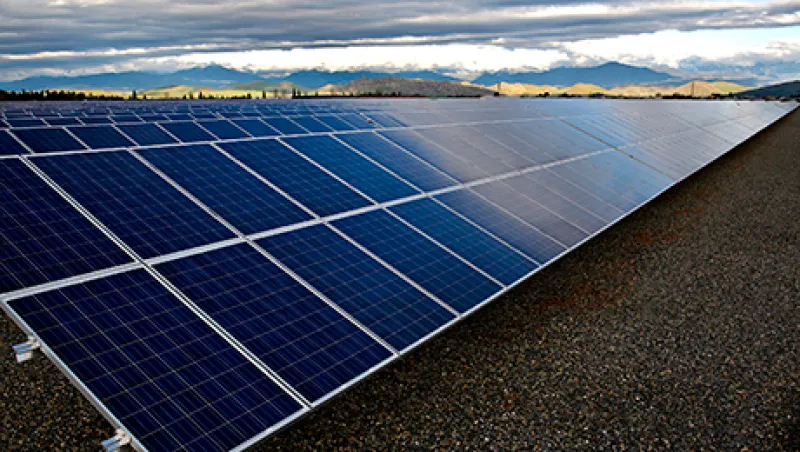A modern dating analogy to describe the relationship between renewable energy yield cos and their hedge fund investors might go like this: Yield cos are looking for a long-term commitment and really should stick to Match.com, but they just keep hooking up with hedge funds on Tinder.
The two are incompatible. This mismatch was in full display during the third quarter, when yield cos discovered that a large swath of their investors were suddenly no longer that into them. From the end of May through September, the Bloomberg North American Power Yieldco index lost roughly 40 percent of its value — though yield co stocks have since rebounded slightly. This sell-off is the result of a lack of commitment from long-term investors, sources say.
“As a sector, we have an investor relations problem,” says Nat Kreamer, chair of the Solar Energy Industries Association, a trade organization, in San Francisco. “We haven’t done a good job attracting the right public equity investors. Many of the yield cos’ public equity investors are hedge funds, which have short-term strategies. This is a mismatch for an investment that has a long-term investment horizon.”
Yield cos are designed to buy renewable energy projects from their parent companies, collect revenue from selling electricity and then use that revenue to fund more acquisitions and make dividend payments to shareholders. Analysts estimate that, before the sell-off, roughly 50 percent of yield co stocks were held by hedge funds. Where that percentage stands today is unclear. What is clear, say analysts, are the reasons why the partnership between yield cos and hedge funds is a bad idea.
“The yield co investment model is inherently one that will require future capital raises,” says Patrick Jobin, an alternative-energy equity analyst at Credit Suisse in New York. “Continued capital formation is normal for infrastructure funds, pension funds and many long-term investors. Hedge funds are not the natural owners of these vehicles, principally because their investment horizons tend to be shorter and, as such, they typically are not participants in continual capital raises.”
Moreover, hedge funds usually use more leverage than other investors and are exposed to the recent swings in the equity and the commodity markets, meaning they’re facing challenges of redemption and volatility in their own funds. Hedge funds in August lost $78 billion, their biggest monthly monetary loss since the 2008–’09 financial crisis, according to research by Citigroup.
Of course, the funds that sold yield co shares had their reasons. Investors worry about overcrowding in this barely two-year-old sector — at least 15 yield cos have had initial public offerings since 2013, raising more than $12 billion, according to energy data provider Bloomberg New Energy Finance. The concern is that the yield co growth spurt has created too much demand for new projects and driven up prices. Investors are also uneasy about the unproven long-term operational aspects of the wind and solar projects yield cos are gobbling up. And this trepidation extends to the business plans of some yield co parents, such as Maryland Heights, Missouri–based SunEdison and Houston- and New Jersey–based NRG Energy.
SunEdison held a conference call on October 7 detailing a restructuring plan that will cut costs to assuage investor fears about its rapid growth. The call followed an 8-K filing two days earlier in which the company said it would lay off roughly 15 percent of its workforce. The company’s stock has declined 70 percent over the past few months, partly because of an increase in losses after a blitz of acquisitions. More broadly, solar-linked equities in general have performed poorly owing to the economic slowdown in China; the coming reduction of the U.S. investment tax credit, scheduled for year-end 2016; and, somewhat ironically, the depressed oil market. Markets use crude oil prices to determine the price of energy in general, which, especially given the present oil price slump, tends to hurt solar companies.
Critics of this practice say that lumping solar in with oil and gas makes little sense. Moreover, renewable energy analysts point out that the yield co sector’s fundamentals remain solid. Jobin considers the recent volatility to be a “near-term temporal dislocation, not a fundamental issue with the assets.”
And he believes the incongruence of the investor base will eventually sort itself out. “I think it will naturally change,” Jobin says. “The right investor set will become more comfortable with the business models and the growth prospects of the industry. It’s a natural evolution. I’d conjecture that master limited partnerships, when first introduced, had a very limited investor set.”
For the time being, with stock prices down, yields are up, with most landing in the 6 to 9 percent range. As Everett Smith, managing partner of GoldenSet Capital Partners, a Stamford, Connecticut–based project finance and structured capital firm focusing on environmentally friendly projects, puts it: “Some of the yields are pushing up into a range that dignifies the name yield co.”
Get more on hedge funds and alternatives.






